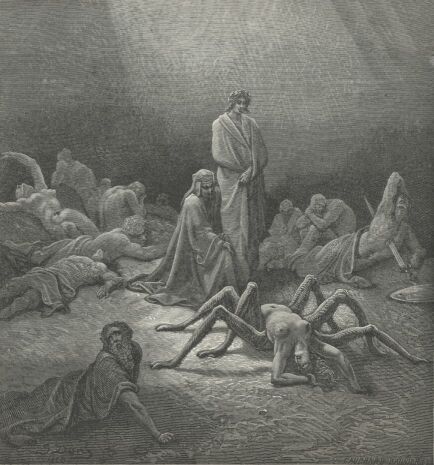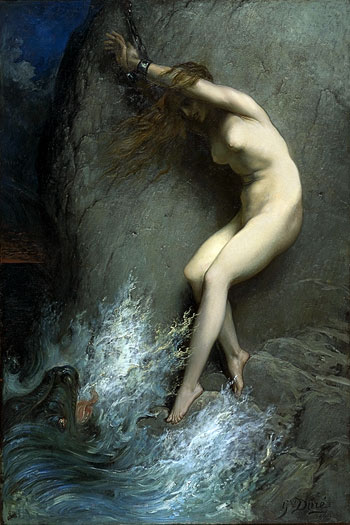 Dore's Dragons, Demons and Monsters by Gustave Doré
Dore's Dragons, Demons and Monsters by Gustave DoréMy rating: 5 of 5 stars
Gustave Doré is pretty awesome. Few artists' works embed themselves in my mind the way Doré's do. I think seeing his illustrations to works like Paradise Lost, Don Quixote, and The Divine Comedy have excited me to eventually read those stories more than all the talk surrounding these works that I've heard in my English classes. That might mean I'm just a lazy reader, or it might have something to do with the long tradition of illustrations accompanying literary works. These days, it feels to me like such a fusion of the arts is less encouraged, even looked down upon. "Serious" literature doesn't bother with pictures, but is all wrapped up in the magnificence of language (except who's gonna say that Paradise Lost isn't serious literature, or an example of weak language?). Should I blame the modernists who brought us formalism for that? Probably not. In any case, it seems like outside of the (now overly popular and rather bloated) graphic novel, and the (unfairly overlooked) picture & pop-up book, that pictures have been snubbed out of literature. Some might say it's because visual arts have somehow found their way into literary language itself, and that there just isn't a need for it, because some writers adopt a cinematic, visual style anyway. I guess you can argue that such a thing as cinematic language exists, but I think there's room for a counter-argument as well - language has always had a visual or cinematic quality in the hands of the right people. (Now I'm just rambling.) Basically, Doré is pretty fabulous, and we should still read books with pictures.
This modest collection of illustrations from Dover is a great introduction to Doré's work. It's a really good highlight reel, that gives to a solid taste for what he's doing. There are no essays accompanying these illustrations, which might be a bummer to those of us who like reading such things, but it's also really cool to have only the illustrations, standing on their own merits. The illustrations are strong enough on their own that explanation as to why they're so great seems extraneous. (Which might mean this review is irrelevant - just a sign of my own pretentiousness. Fair enough.) Essay and critical work on these pictures is cool, but unnecessary for this particular edition. If I want a more extensive analysis and collection of Doré's works, I'll be able to find them, but this book gives me a satisfying first taste.
The illustrations contained here have a spiritual, mystical, mythical quality that carries them beyond simple depictions of demons and monsters. Horror and the grotesque are here in abundance, but serve as a reminder that there are many things in the world that are much bigger than us and are beyond rational comprehension. Sometimes these things present a very real danger to us, but it doesn't always have to turn out like that. Some of these demons and monsters look rather humorous, and are likely meant to, which makes me think that not everything that appears to be an evil demon always is. And in any case, while the horrors of the rational or irrational world might surround us, this also doesn't mean we will be destroyed by them. Many of the works Doré was illustrating didn't end in the complete destruction of humanity - quite the opposite. So there seems to be a kind of inverted optimism or positivity to the pictures that I find really fantastic.
If this is an artistic style you like, then I'd really recommend checking out this book. If it isn't your style, maybe give it another chance before moving on to your already accepted preferences.
View all my reviews
In case you've never seen a Gustave Doré illustration before, here are a couple examples of the coolness:
 | ||
| Arachne |
 |
| Andromeda |
 |
| From Edgar Allen Poe's "The Raven" |

3 comments:
Awesome review and awesome pictures. What a cool dude. I'm glad you got that book.
Also, I have a little bit of a hard time with the Andromeda one, just because if you were naked and chained to some rocks with your feet in the ocean, you're not gonna be pristine and white. That's probably not the point--classical Greek/Roman perfect body whatever--but still. I'm having a hard time looking at it without noticing that her wrists aren't all chafed and her feet aren't all bloody. Oh well, he's still awesome, and it's a cool picture.
I had a feeling you'd love Andromeda most. I remember hearing something from an art history buddy of mine about white also symbolizing death? I think that's what it was. That might be wrong - check wikipedia. In any case, I think the color, composition, and everything comes together quite well in that picture. That she's not all barked up seems to somehow enhance her vulnerability. Though you could probably also see it as somewhat pedestalizing and objectifying, but I don't really. But it's okay if it doesn't quite fit your personal taste. There's always Arachne, which might still be my favorite.
Post a Comment